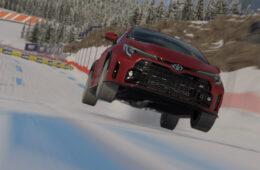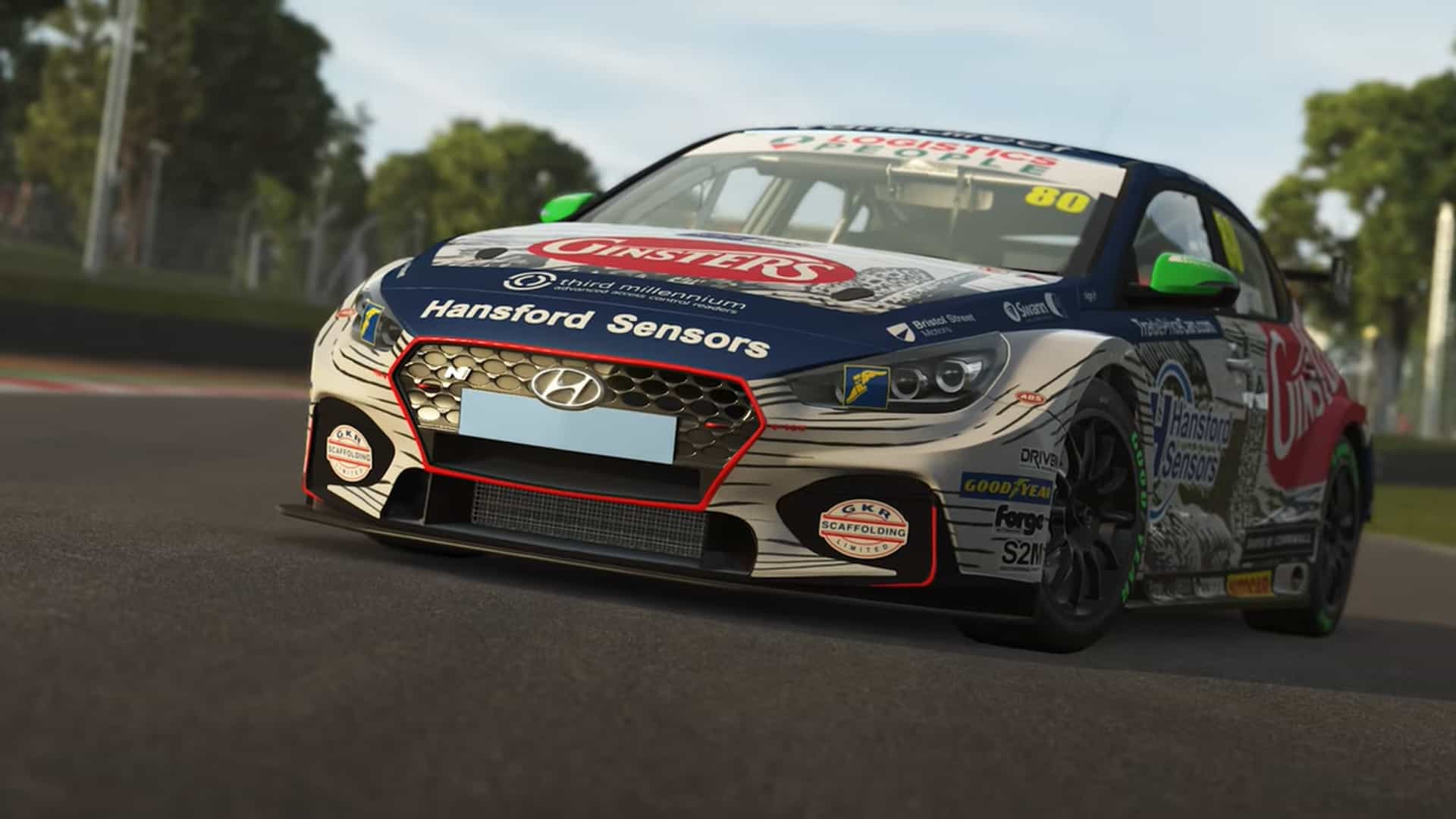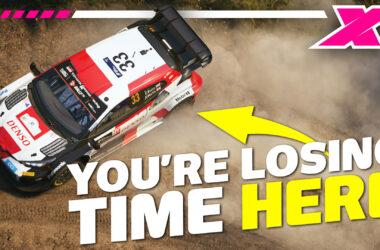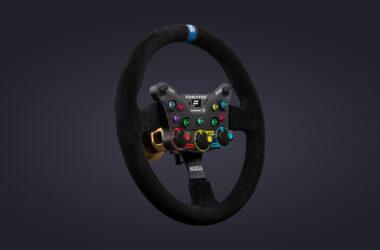I have been sim racing for several years now, and in that time, we have seen plenty of significant technical developments. Whether it’s the games themselves with physics and graphical improvements, or the advancing world of steering wheels, rigs and general peripherals, playing racing games has become more serious than ever before.
This has led to the highly competitive world of sim racing and racing esports, with professional teams and drivers looking to drag every last tenth out of their machinery. To assist with this, people are recording data and analysing telemetry more than ever before, which has led to several businesses developing their own tools to facilitate this.
Recently, the wonderful people at Racelogic got in touch and asked if we would like to try out the latest version of their VBOX simulator software which is currently available in early access, and it was very easy to say yes.
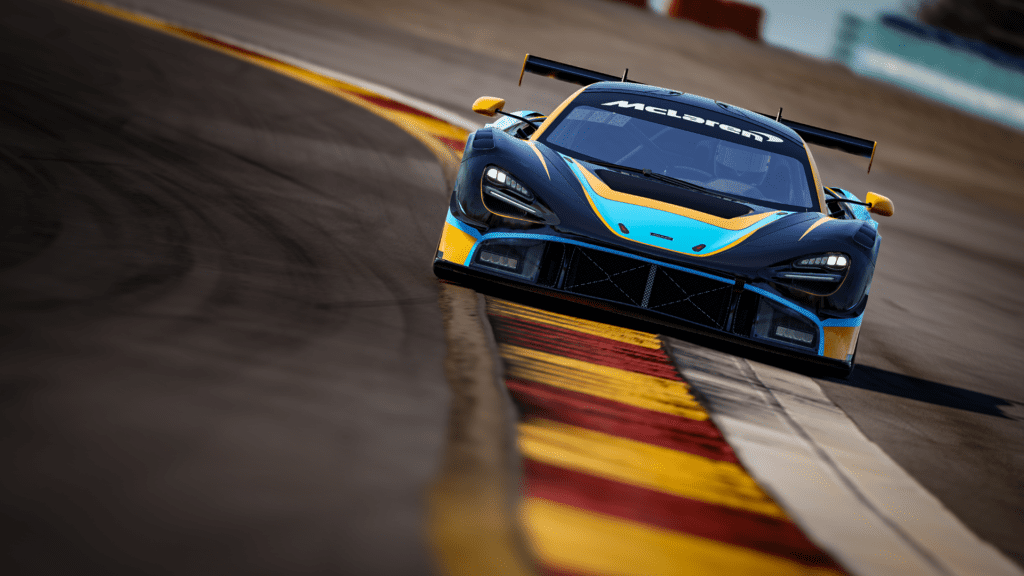
In the following, we aim to show you how it works, what it can do, and hopefully help you decide whether this is something worth investing in for your sim racing career.
For full disclosure, we were sent this software by Racelogic, but all thoughts and opinions in this video are my own, you can read our full review policy below.
Now, going back to what I said earlier, why was it very easy to say yes?
RACELOGIC’S REAL-WORLD ROOTS
You may well recognise the name Racelogic if you are an avid motorsport fan, as many of their products can be found within factory GT machinery. With game developers now recreating cockpits with incredible precision and detail, these in-car Racelogic timers are also beginning to appear in sim racing.
On a personal level, I have been using Racelogic hardware and software ever since I started circuit racing back in 2015. Ironically, I first won a VBOX lap timer in a sim racing competition as a spotty teenager with bad hair.
Since then, most cars I have raced and teams I have raced with also use a range of VBOX products of their own, from lap timers to pit lane timers and video and data recorders. Even just last weekend I used three different VBOX products across two cars.
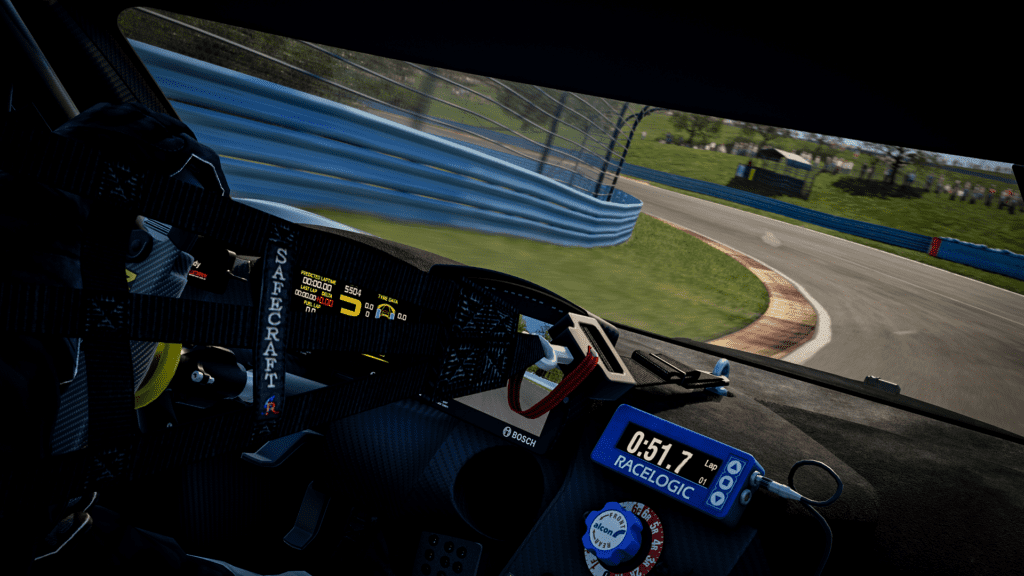
“Why is all of this relevant for a video about the simracing software?” I hear you ask, don’t worry I will come to that.
After a test, qualifying or race session has finished, I grab the SD card from the car, and pop it into my laptop. On this SD card, you will find VBO files for every run, and if you have the VBOX Video recorder, you will have matching video files.
You then have to load up some free Racelogic software called Circuit Tools, and this is where the magic happens. Within Circuit Tools, I can analyse any of the laps I’ve done and compare them to any other laps, whether they are from the same day, the same driver or even the same car.
I can study optimal sector times to find out the best methods for each corner; I can look at throttle and brake traces to see who was able to get the power on earlier or who was able to brake later and I can look at speed traces to see who carried more speed through a corner or who managed to get a better exit.
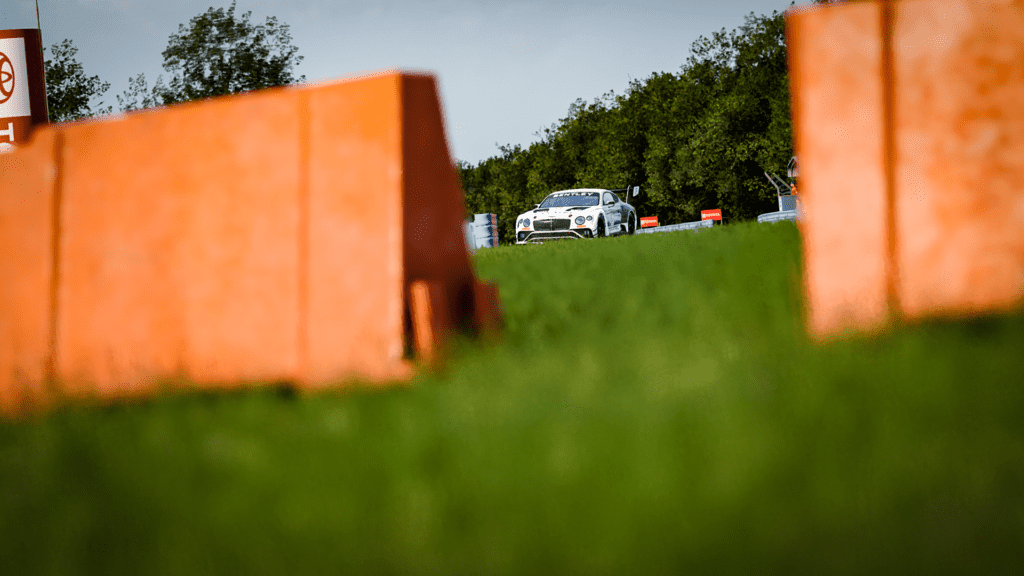
All of this stuff is hugely important for racing drivers, whether it’s being used by one person to compare their laps, or to compare two people’s strengths and weaknesses across a lap. In a Pro-Am GT outfit (one professional driver and one amateur), the Am driver can immediately see where they are losing time, whether it’s on corner entry, apex speed or corner exit.
It can even be used to analyse set-up changes or differences between different cars. How much speed will I gain on the straights by using less rear wing, how much time will I lose in the corners? Or why is the Porsche a second a lap quicker: is it braking, acceleration, cornering or top speed?
So back to the question I asked earlier… How is all of this related to the simulator software? Well, because it does the same job in the same way.
VBOX Simulator Software in action
The Simulator Software, which will cost you £99.99, acts as a video and data logger, creating the same types of files as the regular VBOX systems – and this can be used through the very same circuit tools software in the very same way.
With the system installed, you can analyse lap times, compare lines, set-ups and even compare different sims to one another with the same car and track combo! At the time of making this video, this tool is compatible with most major sims on the market, but not all of them.
Automobilista and Automobilista 2 are glaring omission, although they should still be compatible through using the rFactor and Project CARS 2 outputs. A full list of compatible games can be found on the VBOX website.
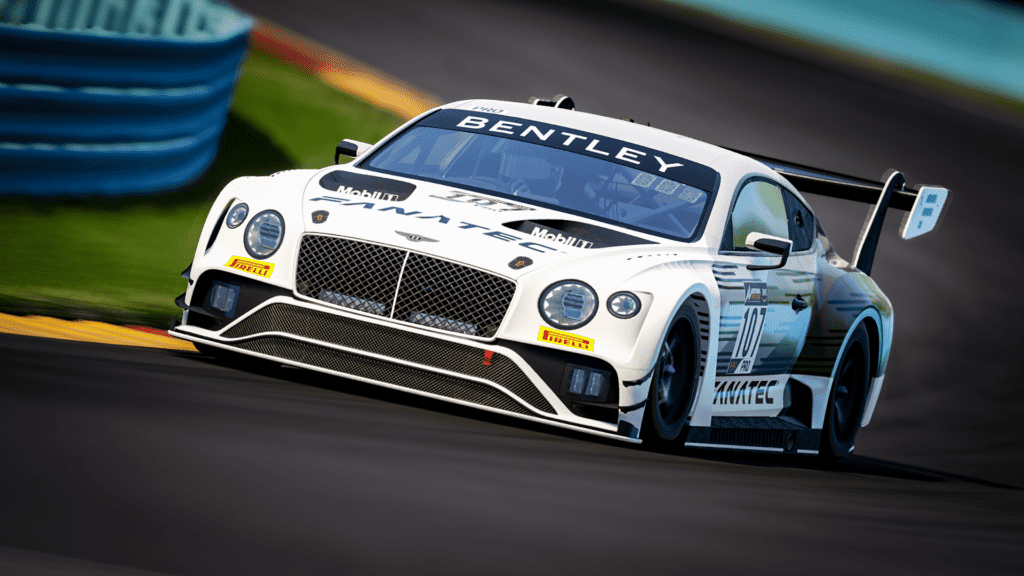
I decided to jump on Watkins Glen using Assetto Corsa Competizione‘s (ACC) and compare a few different scenarios. Firstly, I wanted to know how much of a difference there would be between ACC’s ‘safe’ and ‘default’ set-ups.
I fired up the trusty Boatley and headed out on the ‘safe preset’ for my first run. It felt as expected, a bit understeery and lots of traction control intervention. A bit safe, then. This allowed for some consistent running straight out of the box, and on my last lap, I pushed a bit more to achieve a 1m:44.8s.
Next, it was time for the ‘aggressive default’ set-up, which tends to be a bit quicker but less stable. As expected, the car turned better and felt less compromised on power application, with less overall understeer. There were a few invalid laps and I left some time on the table, but the final lap was a 1m:44.4s.
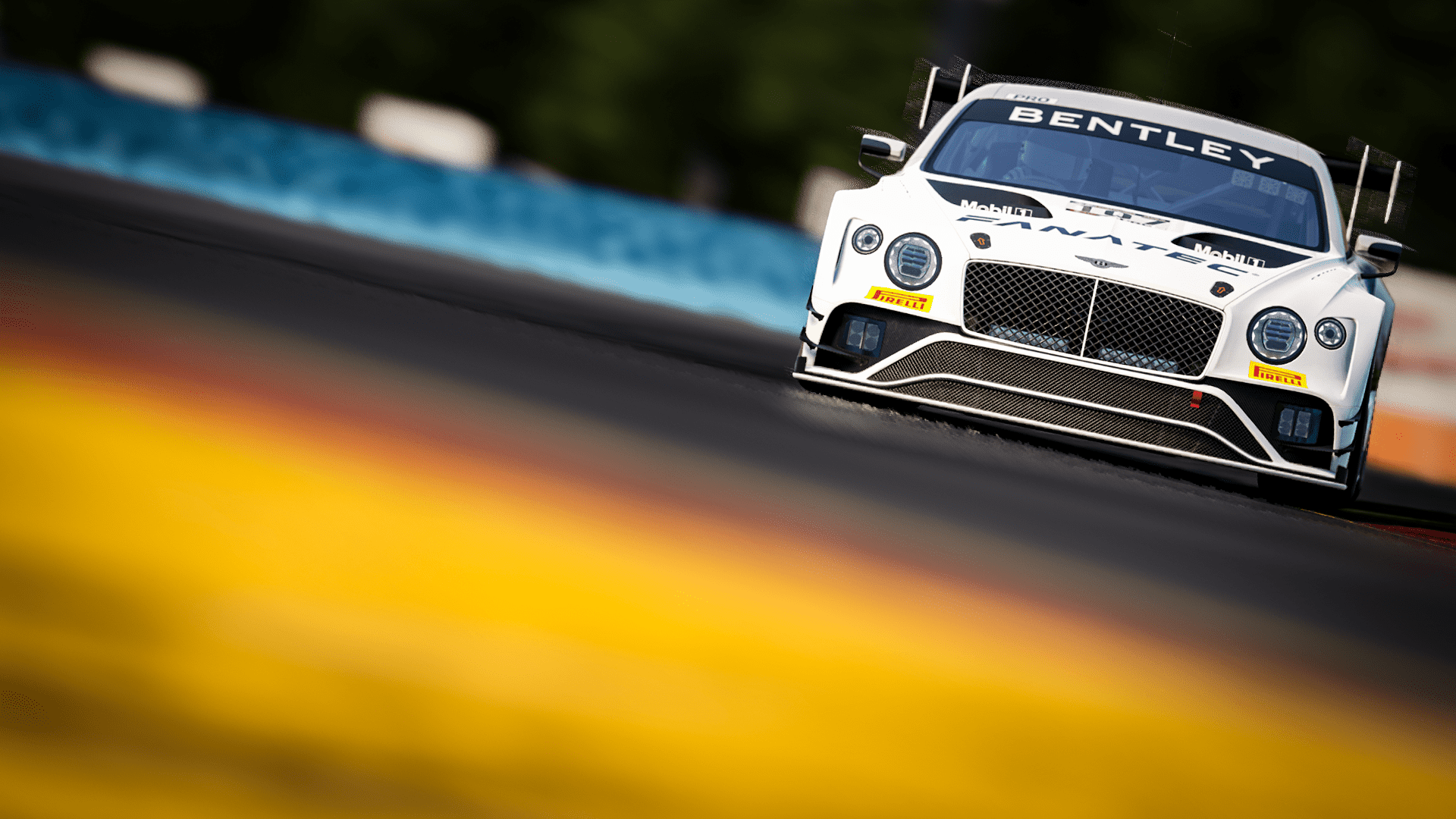
Finally, I wanted to try out a different style of car to see just much the telemetry could reveal about the differences. I jumped in the McLaren and again went with the ‘aggressive default’ set-up. As I’d never driven this car around Watkins before I expected to be a bit slower, but within six laps I had beaten my Bentley time.
However, my gut told me I was losing time through the fast chicane due to the high kerbs on corner entry. This car requires a different driving style: you need to coast into corners more as the car doesn’t turn in as well on the brakes. But you can carry lots of mid-corner speed and it allows you to get on the power super-early, which is why the lap time was immediately quicker.
I should briefly mention that I did have some issues with the VBOX video captures in 4K, but have had zero issues in 1080p. There is also an OBS integration option which might be worth your time should you get your hands on this software.
With all of that said and done, it was time to load up the telemetry and see what it revealed.
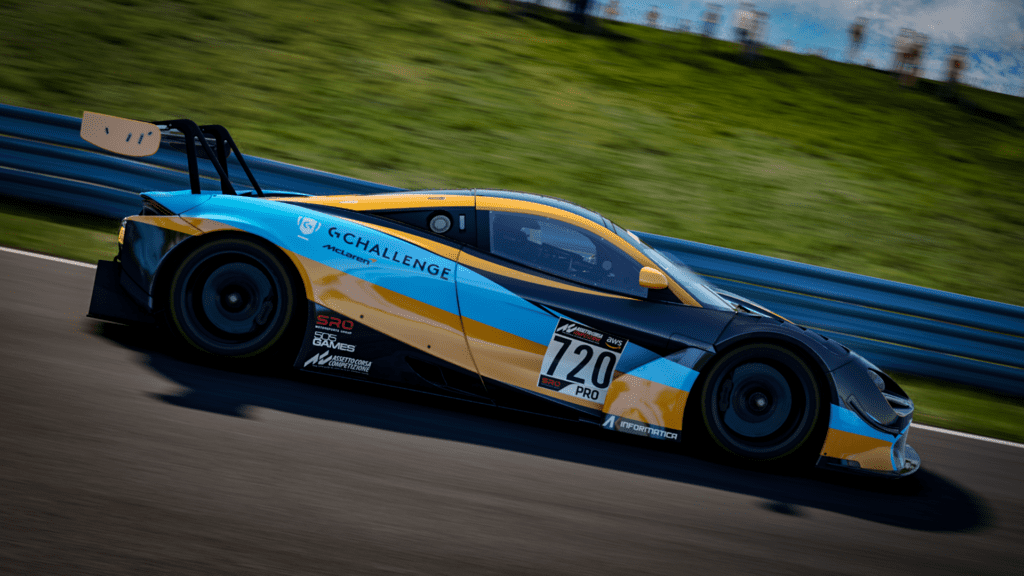
TELE-CASTING
The set-up test is up first, and for reference, the blue border is the safe set-up while the red border shows the aggressive set-up.
Through Turn 1, red has a higher apex speed, which resulted in an advantage of five hundredths by corner exit. By the time they reached the Chicane, it was a full tenth.
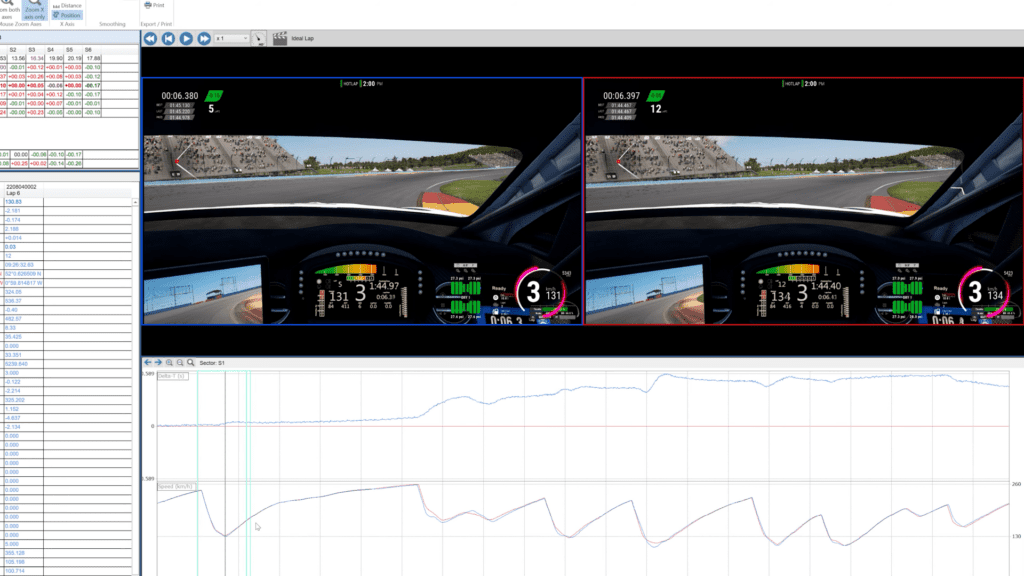
Into the chicane and you can see that blue brakes earlier, and then gets off the brake later, meaning that red is now three-tenths of a second ahead.
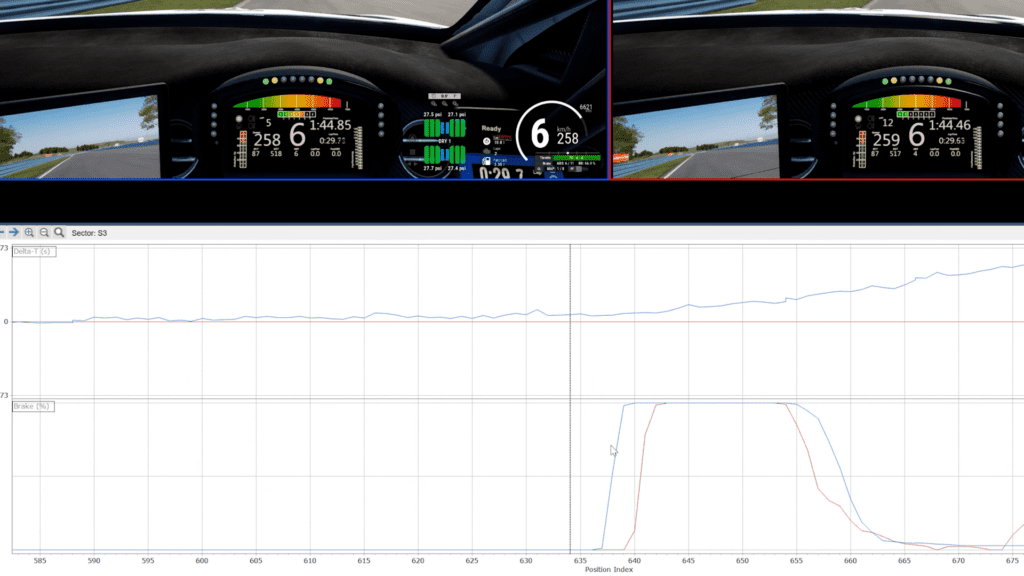
Down into the Chute, and blue is both slower on entry, and later on the power at corner exit. Red gains another tenth.
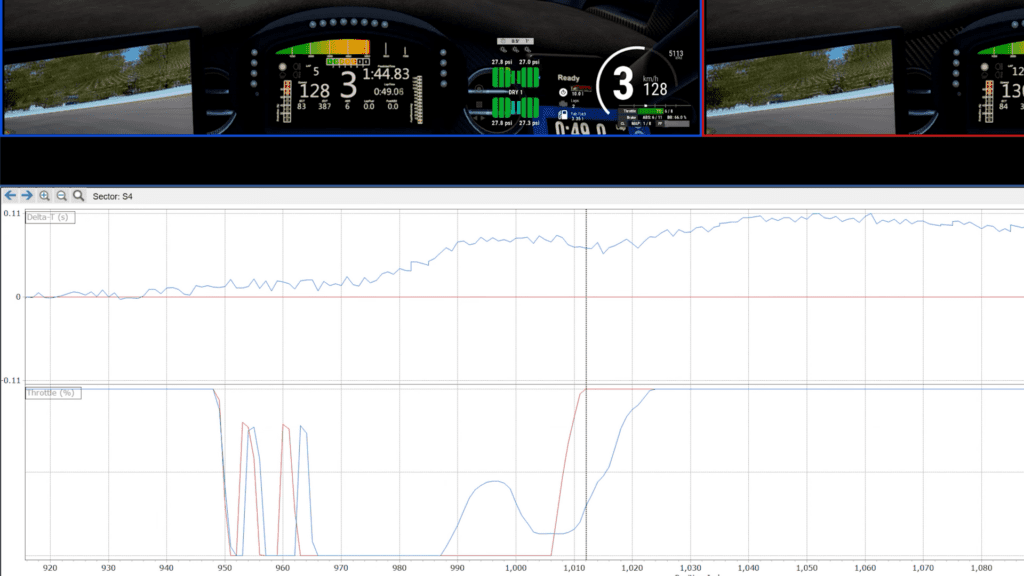
The next section of the lap revealed a very interesting pattern…
Heading into Toe, blue rolls in faster and is later on the brakes whilst red hugs the kerb. Blue gains time therefore on the entry, loses a lot midway through the corner but is then able to cut back across and get back on the power earlier, gaining back some of those losses. This is a great example of the data showing the differences between a v-shaped line and u-shaped line.
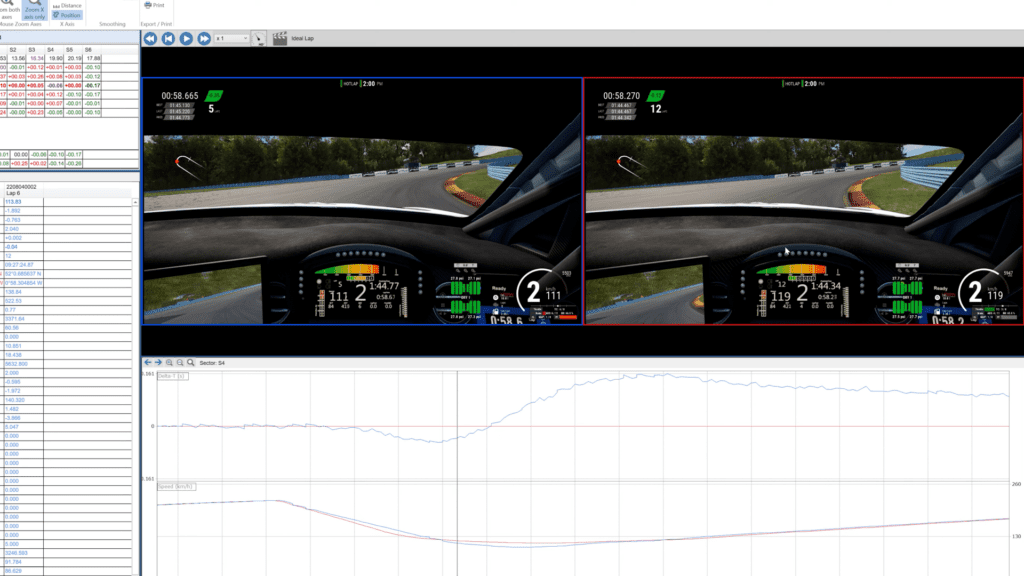
It was a very similar idea into Heel. Blue carries more speed in, drops mid-corner and picks up a good exit. This suggests I was subconsciously compensating for the lack of front end on the safe set-up, by going in quickly, rotating the car and then powering straight back out again.
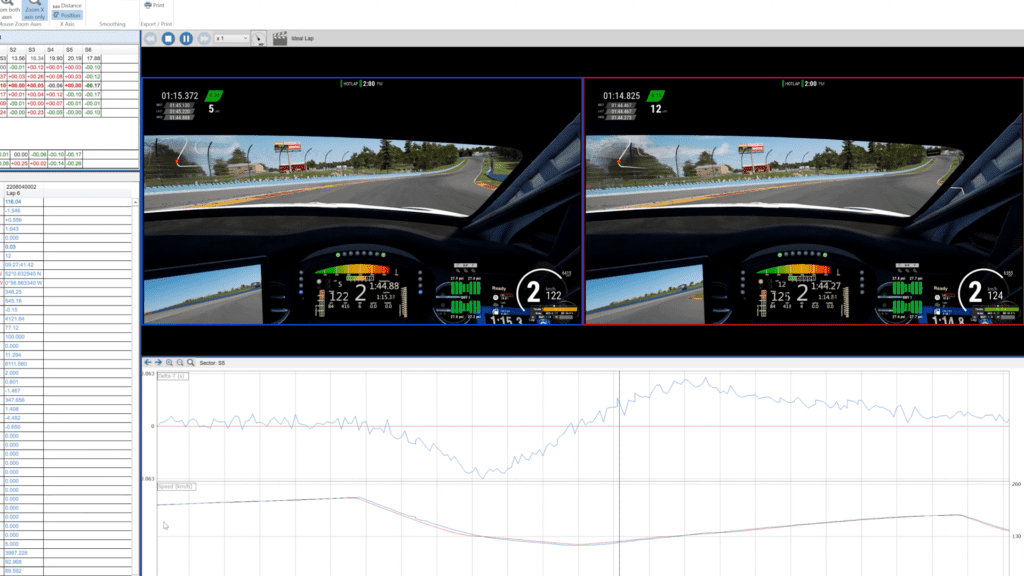
Exactly the same happened on the uphill left-hander, blue gains on entry, loses mid corner, gains on exit, but is ultimately a little slower.
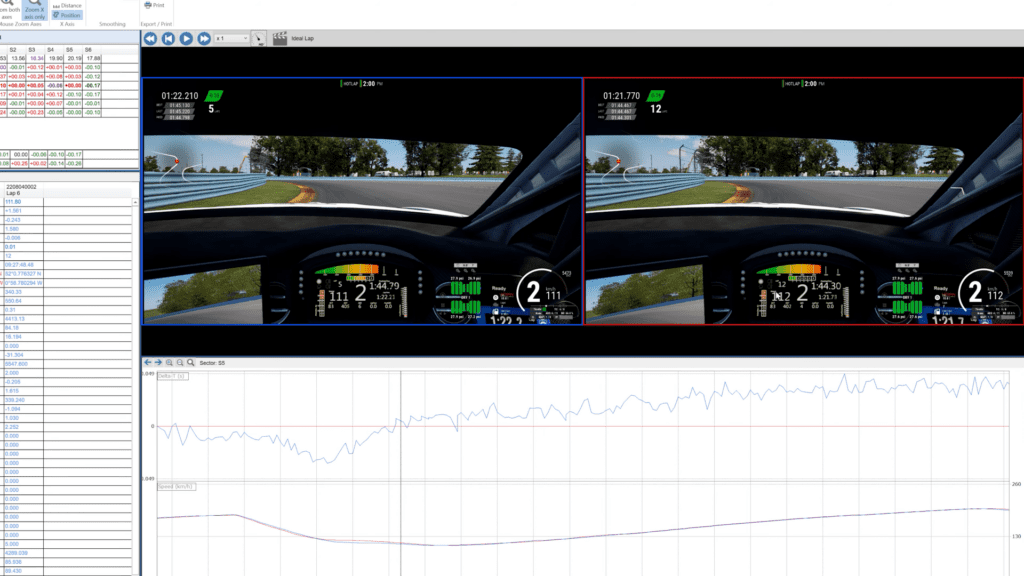
The final corner was the first where blue was quicker than red, and this is because with the aggressive set-up I got on the kerb too much at the apex, but overall you could see the benefits of the aggressive set-up through the corners.
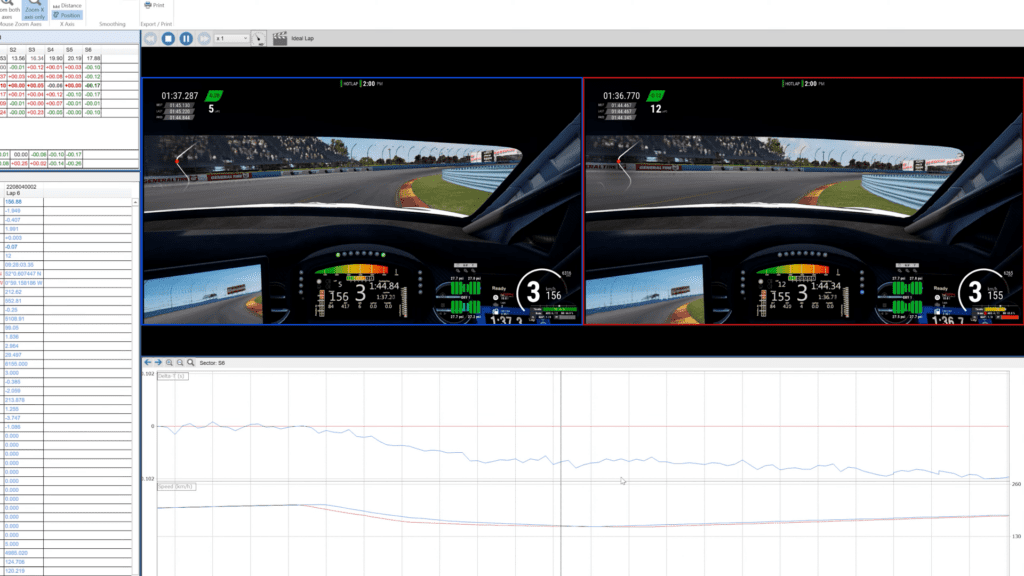
So what about the aggressive set-up on the Mclaren?
Through Turn 1 the McLaren’s apex speed is lower so the Bentley gains on the exit. However, heading up the hill the Mclaren begins to gain speed and time back. By the end of the straight, you can see the difference in top speed.
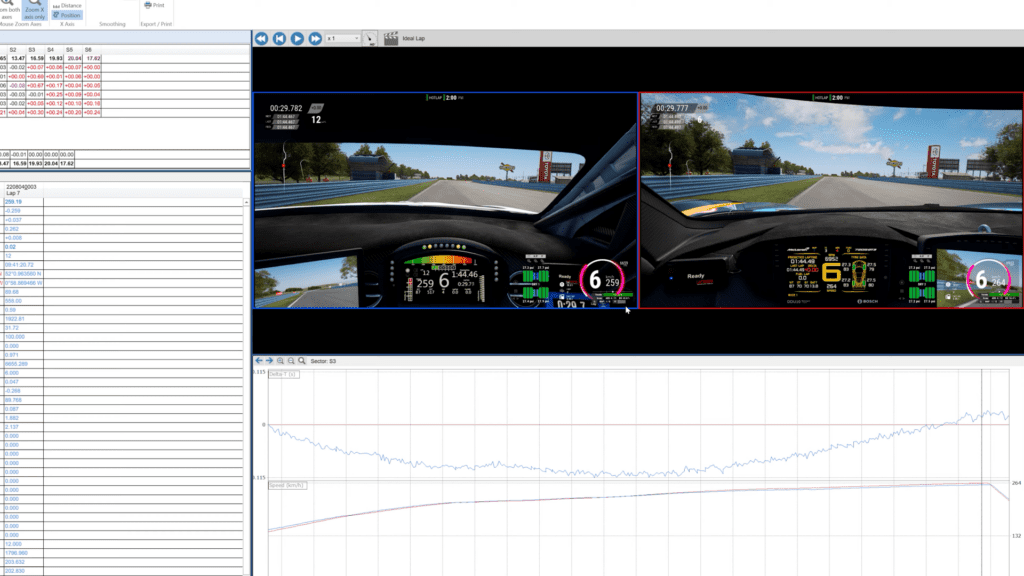
It then loses all of those gains through the chicane as I expected. 10kmh slower at the apex because I couldn’t carry the speed over the kerbs.
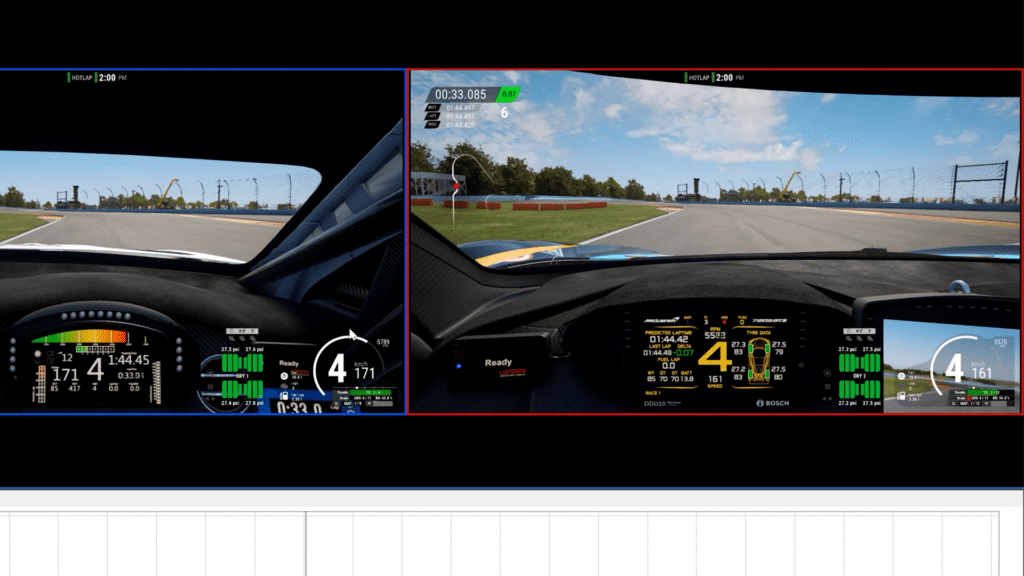
The McLaren does then go quicker into the outer loop but that meant I had to delay the power so it was slower on exit.
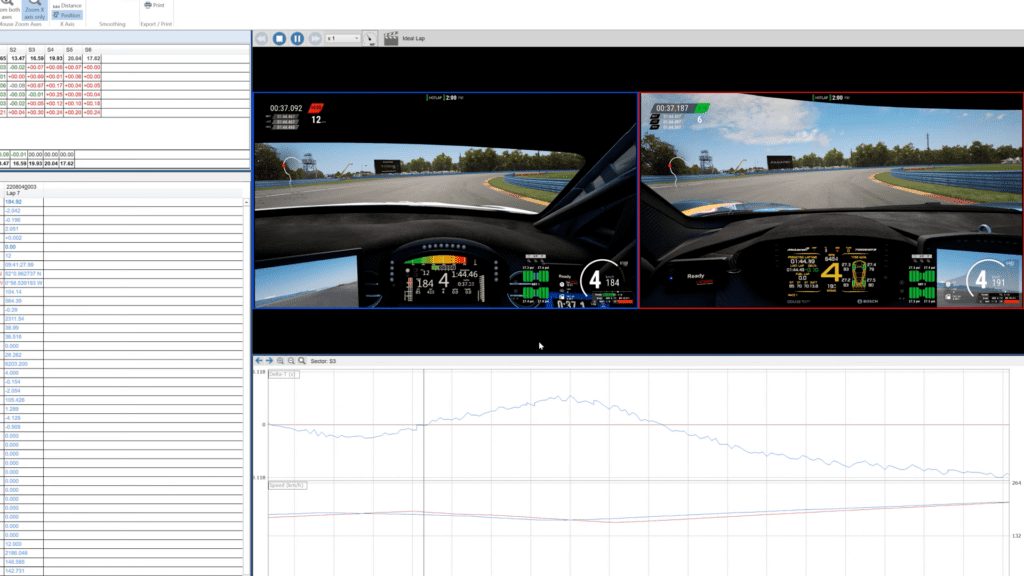
As they head down through the chute, the Bentley is 0.35s ahead, but it’s all up from here for the McLaren.
So far we have had lots of fast corners but the later half of the lap is a lot slower. Looking at the data through Toe, it becomes clear, like I had suspected, that the McLaren has better low-speed traction, allowing for early throttle application out of the corners. Here on the exit, you can see that I have to modulate the throttle with the Bentley, whereas in the Macca, I can nail the throttle with no hesitation.
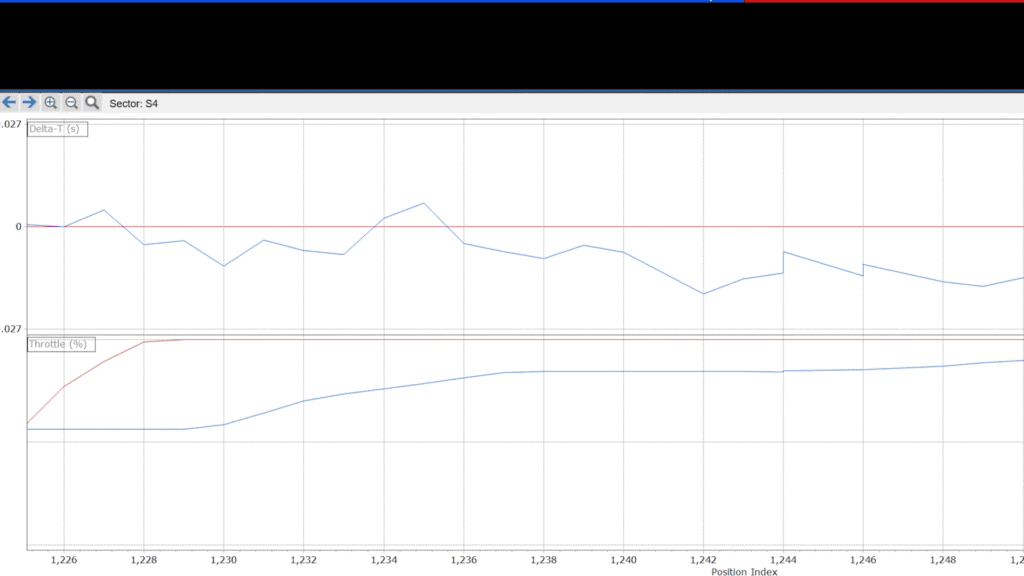
The same thing happens through Heel, the McLaren is full throttle while the Bentley struggles to get the power down.
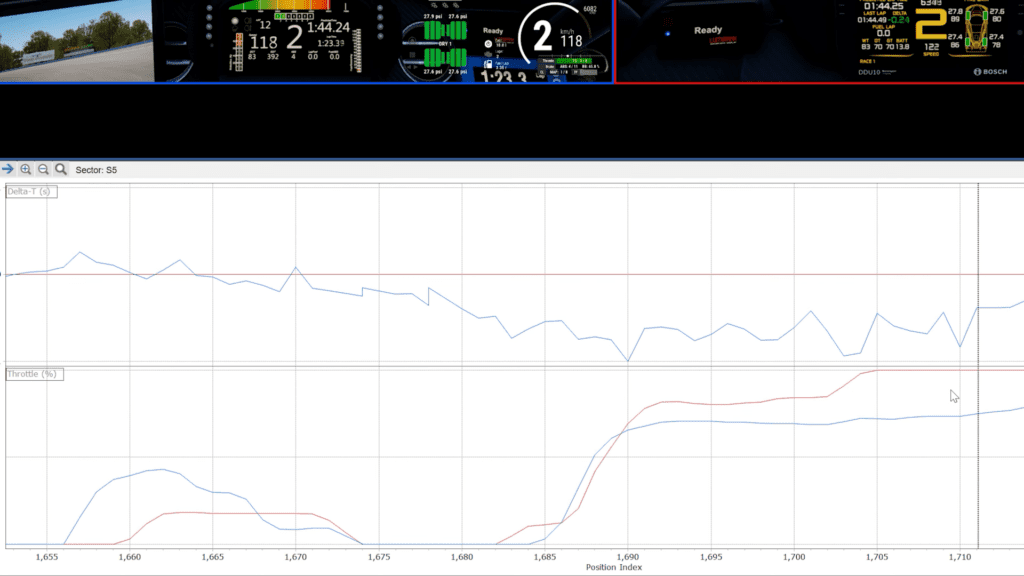
Same again up through the left-hander, and again through the penultimate corner. By this stage, the McLaren has pulled the three tenths back, and then in the final corner, as the Bentley gets on the kerb, the McLaren romps away for a 1m:44.3s.
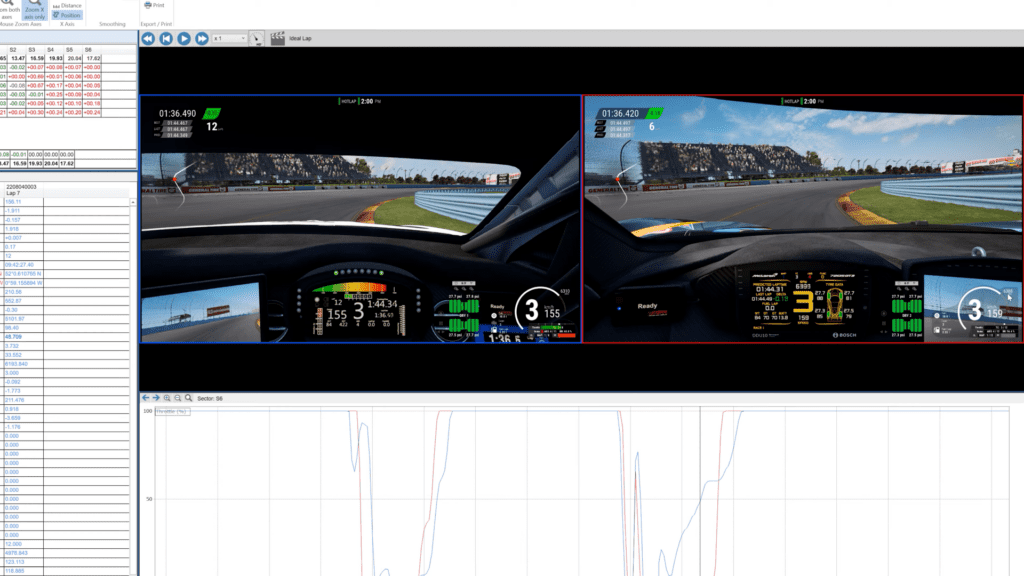
I have to say, based on my experiment here, the data delivered categorical evidence of what was making the difference, and a lot of it backed up my initial predictions. Some things though like the use of v-shaped lines for safe set-up and u-shaped for aggressive were subconscious, and the data made it abundantly clear. All in all, it’s Impressive stuff!
Is Racelogic’s VBOX Simulator Software worth it?
Is this simulator software a worthy addition to your sim racing library? To answer, first let me return to the cost. It’s £99.99 in its current early access state, which equates to around about €120/$120 given the current exchange rate.
This means it’s not going to be for everyone, especially those on a tight budget. It will, however, benefit sim racers looking to take that next step In performance and really get the best out of themselves in a higher level esports event.
This is also a great tool for simracing teams and engineers, who can use data from several drivers to compare things and work out how to maximise any scenario. The other nice thing about this is even though a lot of what you learn is based on comparison, you don’t need a friend, rival or teammate to compare yourself to. You can be that rival, trying different set-ups and driving styles to find your optimal performance.
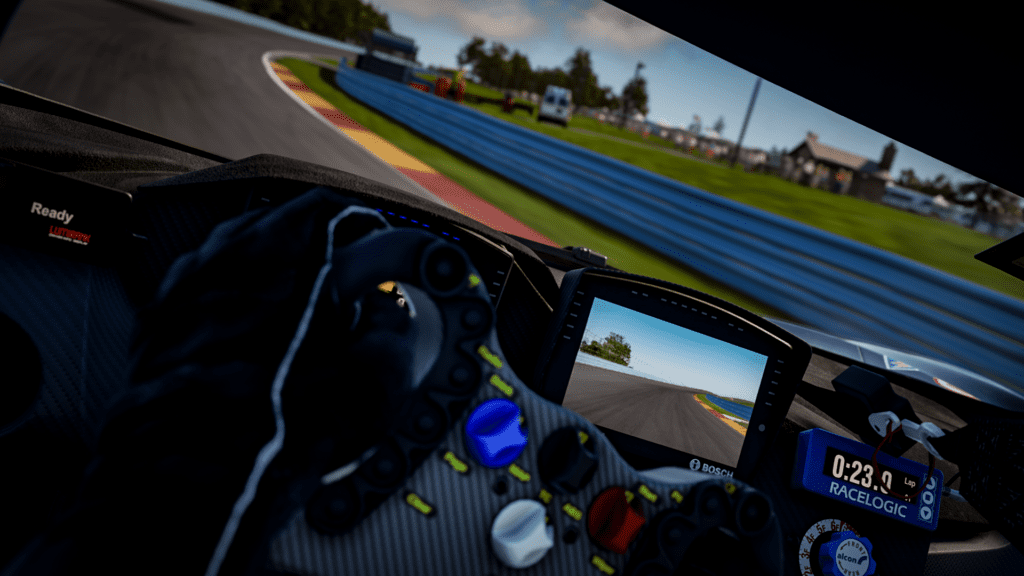
I should also mention that you can use the simulator software in conjunction with the VBOX LapTimer. This works in the same way as it does in analogue motorsport, showing you a live relative lap time delta to the nearest hundredth of a second as you lap the circuit.
However, the Sim Pack that includes the LapTimer with accompanying cables, mounts and cards will set you back £750. That is… a lot. And when you consider that most racing games including iRacing, Assetto Corsa, Assetto Corsa Competizione, rFactor 2 and RaceRoom already have their own in-built relative lap timer, it doesn’t feel vital.
And yes, the in-game versions might not be quite as clear, accurate or user friendly as the VBOX, but it won’t cost you the equivalent of a full tank of diesel in the UK right now (that’s an exaggeration, but give it time!).
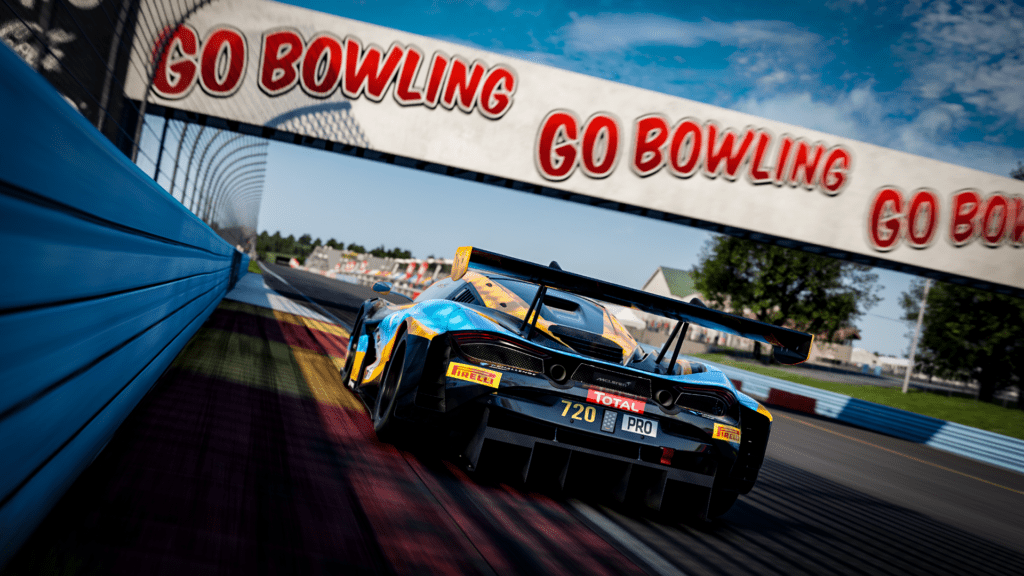
The LapTimer may be surplus to requirements, but it’s still a great addition if money is no object. If cost is a factor, however, you need to spend smart on your simracing ecosystem, and the VBOX Simulator Software provides excellent value for money if you want to step up yours or your teams’ driving.
Or you can just use it to laugh at how bad your mate is at driving; using science, stats and statistics to back up your argument. Powerpoint anyone?
What do you think of the Racelogic VBOX Simulator Software? Is analysing telemetry a welcome addition to the world of sim racing or does it all feel a bit too serious? Let us know what you think in the comments below.
Full disclosure: The Racelogic products written about here were provided by the manufacturer for review purposes. Here is our review policy.




